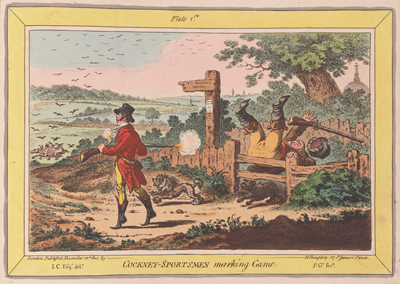Cockney Sportsmen Marking Game
This is the initial plate of a series, Cockney Sportsmen, etched by Gillray and devoted to satirizing the hunting skills of its two cockney protagonists. The series consists of four plates and includes:
- Cockney-Sportsmen Marking Game
- Cockney-Sportsmen Shooting Flying
- Cockney-Sportsmen Re-Charging
- Cockney-Sportsmen Finding a Hare

© Beinecke Rare Book and Manuscript Library, Yale University
This is the second such series devoted to hunting produced by Gillray in the same year, 1801. The previous series appeared April 8 and was based on drawings by the Bishop of Winchester, Brownlow North. It included Hounds Finding, Hounds In Full-Cry, Hounds Throwing-Off, and Coming-in at the Death. The humor there depended upon the portrayal of the pratfalls and equestrian mishaps resulting from the chase. It looked back in time to the basically non-satriric humor of Henry William Bunbury in such series as Hints to Bad Horsemen. The series was said to have been a favorite with the King. But it must have been also popular with a wider audience to prompt a second series as soon as November 12.
But Cockney Sportsmen is quite different. Unlike the Brownlow North series. it features only two characters who appear in every plate. And working within another comic caricature tradition, it plays upon an obvious contrast in their physique and characters: thin vs. fat, active vs. passive, fashionable vs. un-fashionable. One aspect of the humor, then, is derived, as in many caricatures and later comedy routines (think Laurel and Hardy), from the discrepancy between the two.
But as different as they are, they have one thing in common: they are both Cockneys, i.e. born and raised within earshot of Bow Bells, and wholly unfamiliar with country life and with the traditionally aristocratic sport of hunting. Most of the humor, then, is class humor, and derives from the perception of what some would consider the hopeless naiveté of its two characters. As the sign post in the center of the print indicates, the scene is set near "Hornsey Wood" which according to the entry for Hornsey in British History Online, was in 1816 "a favourite resort of the good citizens of London." In other words, this is a cockney haunt. And, in fact, the dome of St. Paul's is still clearly in view.
The dogs accompanying these hunters are not the scrupulously trained hounds of aristocratic fox hunts, but in one case an absurdly groomed poodle(?) unrestrainedly yapping open-mouthed at buzzards in the valley below, and what looks like a bull dog mongrel who has overturned his master while running over-enthusiastically beneath the fence. The two hunters are equally out of their depth. One of them obviously aspires to be a gentleman with top hat, frilly white linen neckcloth, short-fronted tailcoat, pantaloons, and elegantly pointed and trimmed hessian boots--more appropriate to the drawing room than the hunt. The other is so fat that he has struggled to get to a sitting position on the fence before his feet have been cut out from under him by his charging dog. The fashionable hunter is so excited by a flock of birds that he fails to understand that these are buzzards and crows feasting on a dead horse, not legitimate game birds like partridge, pheasant, and quail. And he also fails to realize that he shouldnt walk around with his gun cocked, lest his companion is peppered with an unintended dose of buckshot.
The print is signed I.C. Esq. delt. which most commentators assume is yet another alias for Gillray. I'm inclined to agree, and I suspect that Gillray poses (with tongue in cheek) as a gentleman to emphasize and "validate" the inherent snobbery of the print. As usual Gillray's ideas were almost immediately plagiarized in another four-plate series Cockney Sportsmen attributed to Charles Ansell and published about a month later on December 8 by Fores. This wouldn't have surprised Gillray. But he couldn't have anticipated that Cockney Sportsmen would launch an entire industry of cockney characters in print, song, and on the stage for much of the Victorian period, including The Cockney Sportsmen; or, The Adventures of Mr. Jonquil and His Friend Jay by Robert Cruikshank in 1822, and An Evening's Amusement; or the Adventures of a Cockney Sportsman by Robert Seymour in 1846.
NEXT: Cockney-Sportsmen Shooting Flying
Sources and Reading
- Commentary from the British Museum on Cockney Sportsmen Marking Game.
- "Cockney," Wikipedia
- "Hornsey," British History Online
- "British Volunteer Corps," Wikipedia
- Matthew Cragoe, ":Cockney Sportsmen: Recreational Shooting in London and Beyond 1800–1870," New Perspectives on Firearms in the Age of Empire (Ashgate, 2013).
- Thomas Wright and R.H. Evans, Historical and Descriptive Account of the Caricatures of James Gillray #492
- Thomas Wright and Joseph Grego, The Works of James Gillray, the Caricaturist; With the History of His Life and Times, p. 272
Comments & Corrections
NOTE: Comments and/or corrections are always appreciated. To make that easier, I have included a form below that you can use. I promise never to share any of the info provided without your express permission.